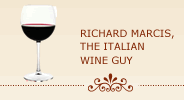Top Ten Italian White Wines for 2022
That Italian white wines are often overshadowed by the country’s red wines may not be a surprise given that Italy’s most famous wines (i.e., Barolo, Amarone and Brunello) are all reds. But Italy produces a lot of white wine, in fact more white wine is produced there today than red wine. Unfortunately, a significant proportion of that production consists of bland and uninteresting varieties (think Pinot Grigio and Prosecco) often plucked from supermarket shelves.
But there is a large number of fascinating and distinctive white Italian wines that are just as diverse in terms of varieties and styles as the country’s reds. The styles range from crisp and refreshing whites ideal for summer sipping to complex versions of considerable depth and structure and capable of long-term ageing. Some whites may even be barrel-aged. In fact, there are so many different varieties and styles that shopping for a white can be as bewildering as shopping for an Italian red.
Indicated below are ten Italian white wines of character and distinction selected from producers throughout the length and breadth of Italy, from Alto Adige in the north to Sicily in the south. Reflecting the diversity of Italian white varieties there is no overlap in the 10 selected wines in terms of grape varieties utilized, even for blended wines.
The wines also exhibit considerable diversity in pricing, ranging from $16 to $55 but on balance are reasonably priced with half the wines in the $25 to $30 price range.
But, regardless of price all wines rate extremely high on a quality-to-price basis. These are wines that you would be proud to serve at any gathering of friends and family or special guests.
The wines are listed alphabetically by producer.
Abbazia di Novaella, “Praepositus” Kerner Trentino–Alto Adige 2019 (about $31)
The Abbazia di Novaella is a working monastery located in the mountainous region of Trentino-Alto Adige not far from the Austrian border. The abbey finances its operations largely through sale of its wines, primarily those made with local, traditional varieties.
Although it is one of the oldest wineries in the world – it was established in 1142 – it has kept current with advances in viticultural practices and wine technology and today is one of northern Italy’s most highly regarded wineries.
Some of the abbey’s most prized wines are made with the relatively obscure – at least to most Americans - Kerner white grape variety. The cold-tolerant Kerner thrives in this rugged, mountainous area and produces aromatic wines with beautiful floral aromas. The abbey’s “Praepositus” is made exclusively of Kerner grapes selected from the abbey’s best vineyards.
Harvested in early October, the grapes are fermented in stainless steel tanks using only natural yeasts that enable Kerner’s natural aromas and flavors to shine. Aged in stainless steel for 10 months it then spends 2 additional months in the bottle prior to release. The alcohol is 14 percent.
The wine has a golden- yellow color with light green reflections and intense aromas of zested lemon intermingled with white mountain flower. It is full-bodied and nicely textured with a rich mouthfeel of ripe peach and apricot flavors and a touch of honey-custard on the finish.
Benanti, “Contrada Rinazzo” Etna Bianco Superiore 2019 (about $52)
This wine is made entirely of Carricante, eastern Sicily’s noble native white variety, grown on Benanti’s high-elevation (2,600 feet above sea level), steeply-terraced vineyards on the eastern slope of Mount Etna. The Carricante variety benefits from extensive day-night temperature variations associated with the high-elevation climate that facilitate production of wines with great texture, varietal integrity and generous streaks of acidity.
The Carricante grapes are hand-harvested from the estate’s Rinazzo vineyard in late October and fermented in temperature-controlled steel vats over a period of 12 days. The yeast utilized is a special strain of an indigenous yeast that has been especially selected by Benanti’s oenologists after many years of vigorous research. The wine is then aged for 12 months in stainless steel tanks on its fine lees (i.e., its spent yeast cells) with frequent stirrings after which it is bottled and spends an additional 6 months prior to release. The wine has a food-friendly 12.5 percent alcohol.
The aromas are rich and generous with notes of dried apricot and apple blossom intermingled with some whiffs of crème brûlée. It has pleasant acidity and a soft but structured mouthfeel most likely attributable to the extended lees ageing that renders this wine a cut above other more linear white wines. It’s worth noting that the 2019 “Cantrada Rinazzo” was the recipient of a prestigious Tre Bicchieri award from Gambero Rosso.
Castello della Sala-Antinori, “Cervaro della Sala” Umbria IGT 2019 (about $55)
Castello della Sala is a magnificent medieval manor located a short distance from the historic city of Orvieto in the Umbria region. Purchased by the Antinori family in 1940, it now has 420 acres of vineyards dedicated primarily to white wine varieties that include both native traditional and international varieties such as Chardonnay and Sauvignon Blanc.
The 2019 Cervaro della Sala is made of estate-grown Chardonnay with a splash of Grechetto that adds some fresh acidity to the mix. The Chardonnay grapes are harvested the last week in August and the Grechetto 2 weeks later. The Chardonnay’s primary and secondary (malolactic) fermentation as well as ageing take place in small oak barriques which gives the wine a touch of wood and enhances the texture.
The Grechetto is separately fermented in stainless steel tanks and after about 3 months is added to the Chardonnay and then bottled where the completed wine rests for a few months before release to the market.
The wine is full and weighty with a silky texture and a full, round mouthfeel accented with refreshing acidity. Some sweet marzipan-like notes give lift to the long and generous finish. 2019 was a remarkable vintage in Tuscany and this wine, while enjoyable now, is capable of extended ageing and can be enjoyed for years to come.
This complex and structured wine is one of Italy’s greatest white wines. This vaunted assessment is shared by others as the Cervaro della Sala is a serial recipient of Gambero Rosso’s prestigious Tre Bicchieri award.
Elena Walch, Gewurtztraminer Alto Adige 2020 (about $16)
Although non-native, Gewürztraminer is considered a traditional variety of the Alto Adige region and is the region’s third most widely-planted variety, red or white. Despite its northern mountainous location, the area experiences warm days with abundant sunshine accompanied by cool evening temperatures. As a result, Gewürztraminer-based wines produced here tend to be richly-textured and bright with crisp acidity.
This Gewürztraminer from Elena Walch is made entirely of 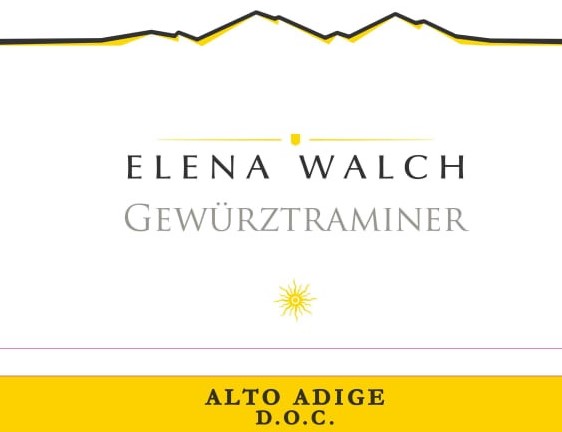 estate-grown Gewürztraminer. The newly-harvested grapes undergo maceration on the skins, then are gently pressed and fermented in steel tanks at controlled temperatures. The wine is then aged on the lees for several months in stainless steel containers.
estate-grown Gewürztraminer. The newly-harvested grapes undergo maceration on the skins, then are gently pressed and fermented in steel tanks at controlled temperatures. The wine is then aged on the lees for several months in stainless steel containers.
This medium-bodied and richly textured wine provides a potpourri of crisp, racy and aromatic sensations. The mouthfeel is excellent with good texture, energetic and crisp flavors and balanced acidity. Good concentration helps create a lingering, zesty finish with some spicy nuances.
The aromatic profile and balanced acidity of this Gewürztraminer make it a formidable companion to a full range of spicy Thai or Indian curry offerings as well shellfish, grilled fish or flavored cheeses.
Garofoli, “Podium” Verdicchio dei Castelli di Jesi Classico Superiore 2018 (about $28)
Verdicchio is one of Italy’s great native white wine varieties. It grows throughout central Italy but the best examples come from hill-side vineyards surrounding the town of Jesi in the Marche region along the Adriatic coast where it has been grown for centuries. Here, one of the two main Verdicchio appellations is Verdicchio dei Castelli di Jesi DOC that encompasses a historic area dotted with medieval castles, hence the word castelli in the DOC title.
The 2018 “Podium” Verdicchio dei Castelli di Jesi Classico Superiore from the Garofoli winery is a premier example of the variety. It is made entirely of late-harvested Verdicchio grapes from the historic (classico) area. The slightly over-ripe grapes are gently pressed, fermented and aged for 15 months in temperature-controlled steel tanks. The wine spends an additional 4 months in the bottle prior to release.
In the glass the wine exhibits a beautiful golden yellow color with a greenish tint on the rim. The un-oaked Podium is lively, complex and delicious with citrus and tropical fruit flavors and a touch of honeyed-hazelnut on the long finish. This wine can go the distance if properly cellared and will age gracefully for years.
Pietracupa, Greco di Tufo DOCG 2018 (about $28)
Pietracupa is a small-scale winery – only about 8 acres of vineyards – near the wine-centric town of Avellino in the Campania region. While small, it punches well above its weight and is generally considered one of Campania’s best white wine producers, which is saying a lot since Campania is one of Italy’s foremost white wine regions.
While Pietracupa produces some reds it’s primary focus is on white wines especially those based on the native Greco and Fiano varieties. Its Greco wines are generally considered to be premier examples of this variety. The best Greco wines are produced from grapes grown around the town of Tufo and carry the Greco di Tufo DOCG designation.
Pietracupa’s 2018 Greco di Tufo is made entirely of Greco from the Tufo appellation. Fermented and aged entirely in stainless steel tanks, it is medium-bodied, soft and aromatic with prominent citrus notes. It has good mouthfeel, concentrated and textured, with interlaced citrus and peachy white fruit flavors and Greco di Tufo’s benchmark vibrant acidity.
Pietracupa’s 2018 Greco di Tufo received a Tre Bicchieri award from Gambero Rosso and, at about $28, ranks exceptionally high on a quality-to-price basis. This wine goes well with a variety of dishes including pasta and white meats but is at its best when paired with fish prepared any which way.
Planeta, “Cometa” Fiano Menfi DOC 2019 (about $46)
The Planeta winery is one of Sicily’s largest with 6 different estates located throughout the island. The “Cometa” is from the Dispensa estate in southwestern Sicily not far from Agrigento.
Planeta’s 2019 Cometa is made entirely of Fiano grapes. Fiano is an ancient variety native to the Campania region but, as this wine attests, has adapted well to its new island environment. 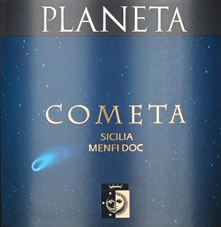
The Fiano grapes for the 2019 Cometa are hand-selected in early September from two separate estate vineyards. The grapes are softly pressed, fermented and then aged with 90 percent in stainless steel tanks and the remaining 10 percent in small oak barriques. After ageing on the fine lees for a period of time, the wines are blended and bottled where they rest for a bit before release.
This medium-bodied wine has a rich mouthfeel and an intense rush of white fruit flavors balanced with acidic tension. Some ripe apricot and almond flavors provide a refined aftertaste. This white has good ageing potential and can go the distance for at least 10 years.
Pra, “Monte Grande” Soave Classico 2018 (about $30)
Soave is one the Veneto region’s best known and distinctive wines - and that’s meant as a compliment. A lot of Soave is produced each year so the goal for any serious wine drinker is to brush aside the light, run-of-the-mill stuff and reach instead for those brimming with character and seductive appeal – like this “Monte Grande” from the Pra winery in the historic Soave area. This aromatic and richly textured Soave will work its magic on you.
The Pra winery was founded in the early 1980’s and although a relatively recent addition by Veneto standards, it quickly earned a reputation as one of Soave’s premier producers. Soave is the winery’s variety of choice and it produces 4 different versions of Soave.
The 2018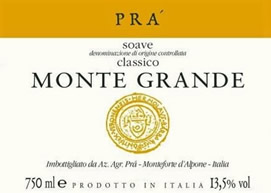 “Monte Grande” consists of 70 percent Garganega, the traditional Soave variety, with the addition of 30 percent Trebbiano di Soave. It is a single vineyard, site-specific wine with all the grapes coming from the estate’s 12-acre Monte Grande vineyard.
“Monte Grande” consists of 70 percent Garganega, the traditional Soave variety, with the addition of 30 percent Trebbiano di Soave. It is a single vineyard, site-specific wine with all the grapes coming from the estate’s 12-acre Monte Grande vineyard.
The Trebbiano grapes are harvested in mid-September while the Garganega grapes are harvested about a month later after the grape clusters have been air-dried on the vine and become slightly raisiny with elevated sweetness and acidity. The wines are fermented and aged in large-format oak casks for 10 months, then combined and aged for a short period in the bottle before release for sale.
Pra’s 2018 “Monte Grande” Soave has a rich and complex mouthfeel with an almost creamy texture intermingled with a fresh acidity that gives lift and liveliness to the elegant finish. It is a lovely, organic, well-priced, food-friendly and engaging wine.
Montenidoli, “Tradizionale” Vernaccia di San Gimignano DOCG 2019 (about $25)
Vernaccia wines from the San Gimignano appellation are Tuscany’s most famous white wine and the only white wine from Tuscany to qualify for vaunted DOCG status.
The Montenidoli estate produces 3 separate Vernaccia wines that are distinguished primarily by the fermentation and cellaring protocols used in the production of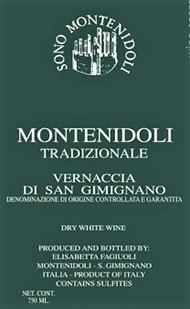 the wines.
the wines.
The “Tradizionale” Vernaccia follows the local traditional custom (hence the name “Tradizionale”) of macerating the grapes for an extended period before fermentation in their juice and grape skins, a process that extracts more complex flavors and textures along with a deeper color.
Montenidole’s 2019 “Tradizionale” is made entirely of estate-grown Vernaccia and has a food-friendly 13.5 percent alcohol.
It has an attention-grabbing bright, straw-yellow color with golden highlights. It is full-bodied and complex with deeply textured ripe yellow fruit flavors, plenty of grip and an amazingly complex finish. The wine combines elegance with structure and also has good ageing potential.
Vigne Surrau, “Sciale” Vermentino di Gallura Superiore DOCG 2019 (about $27)
Gallura is an area on the northern tip of the island of Sardinia that is generally considered the source of the island’s best Vermentino wines. The Vermentino di Gallura is Sardinia’s only DOCG appellation.
The Vigne Surrau winery encompasses 150 acres of vineyards spread among 8 different vineyards in the Gallura area of which 3 are dedicated exclusively to the Vermentino variety. While the winery produces a variety of red, white, rosato and sparkling wines, Vermentino is the winery’s primary variety and accounts for almost three-quarters of its total production.
The “Sciale” Vermentino di Gallura Superiore is made entirely of Vermentino grapes selected from several of the estate’s vineyards. The grapes are fermented and aged for 6 months in contact with its lees in temperature-controlled steel tanks. The wine is then bottled and aged for a short period before release for sale. It has 14 percent alcohol.
The 2019 “Sciale” has an intense bouquet of tropical fruit and citrus aromas. It is full-bodied but elegant and complex with good mouthfeel and lots of white fruit flavors streaked with fine, fresh acidity. The fruit lingers nicely on the long finish.
Note – prices indicated are averages of national retail prices as of this posting. Individual prices will vary from store to store. All wines are generally available and most well-stocked wine shops will carry some if not all the wines listed. But stores may sell out so check their websites or call in advance to inquire about price and availability.
©Richard Marcis
February 10, 2022
Return to italian wine reviews

